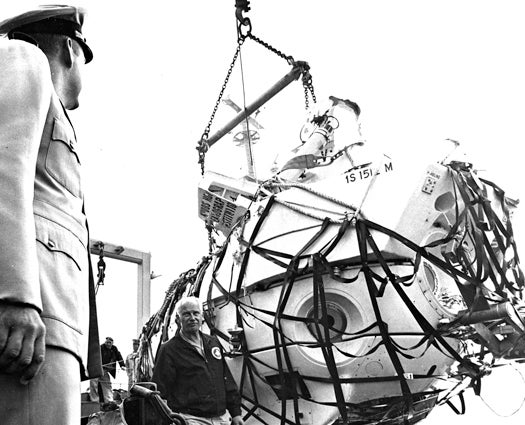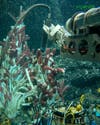Click to enter the gallery
The deep-sea exploration vehicle Alvin has had a fascinating and storied history. Since its launch in 1964, the three-person research vessel has made more than 4,000 dives to the seafloor, to depths of almost three miles. Alvin has discovered strange organisms, sampled the hydrothermal vents where the earth’s crust splits open and even documented the wreckage of the Titanic. Here are some highlights from Alvin‘s many adventures.
Click the gallery to check it out, and see an annotated look at Alvin‘s $40 million makeover here.
June, 1964
The Woods Hole Oceanographic Institution, with help from the Office of Naval Research, realized a decade-long dream of manned deep-sea exploration in June of 1964, with the commissioning of Alvin. Allyn Vine, a scientist at WHOI who was the prime mover behind the project, inspired the name of the three-person deep-sea vehicle. Vine named Alvin‘s tender, the 105-foot catamaran Lulu, after his mother. A pair of craftsmen from Cape Cod constructed Lulu from two surplus Navy pontoons.
July, 1967
On more than one occasion, Alvin has been mistaken for an enemy by denizens of the deep. In July of 1967, a swordfish attacked Alvin off the coast of Cape Charles, at a depth of 2000 feet, and became trapped; the crew cooked it and ate it for dinner.
October, 1968
In October, 1968, Alvin‘s support cables snapped as it was being lowered into the water, and the submersible plunged to the sea floor nearly 5,000 feet below. The next August, the deep-sea vehicle Aluminaut, built by the Reynolds Aluminum Company, hauled Alvin up from the depths. The lunches left onboard were still good, albeit wet, a discovery that opened up new avenues of biological and chemical research into the lack of decaying oxygen deep in the sea.
July, 1986
Jason Jr., a prototype robotic vehicle tethered to Alvin, probes the remains of the Titanic. Alvin and Jason Jr. made a total of 12 dives to take photos and videos of the historic wreck in July of 1986, unwittingly linking Alvin to Celine Dion, and thus Kevin Bacon. (Alvin‘s “Bacon Number” is 4: Kevin Bacon –> Josh Groban –> Celine Dion –> The Titanic –> Alvin)
January, 2002
Alvin collects samples from a black smoker hydrothermal vent along the East Pacific Rise, a boundary under the Pacific Ocean where two tectonic plates diverge. The billowing cloud is not actually smoke, but scalding water, rich in iron and sulfur, meeting chilly water. Despite their scalding hot temperatures, hydrothermal vents are home to some of the hardiest bacteria ever discovered.
September, 2002
Alvin‘s pilot uses two hydraulically-powered robotic arms to probe tube worms in the East Pacific in September, 2002. The arms have clawed hands, which can be used to deploy scientific equipment and collect marine organisms.
Through 2013
Behold: Alvin through the ages. The submersible’s evolution continues with a round of improvements that began in 2011 and will continue through 2013, after which it will boast sharper cameras, a heavier payload for collecting samples and more sophisticated undersea mapping capabilities.







